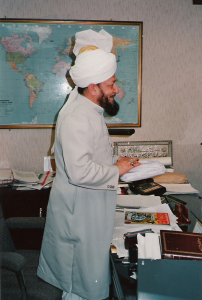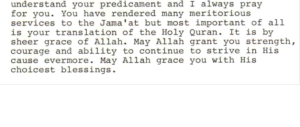The Holy Qur’an, Swedish translation 1988
While I was residing in Frankfurt am Main, Germany, his holiness, hadhrat Mirza Nasir Ahmad, the third Caliph after the Promised Messiah, wrote to me that he wanted me to translate the Holy Qur’an to Swedish. I was shaken; I could never have imagined that such an important work would be entrusted to me. I was sure I was not competent enough for this important work, so I wrote exactly this to Hadhur.
In my mind I was terrified of the thought that I would most probably make mistakes in the translation and I was afraid of Allah’s anger. I started to pray that Allah may forgive me my shortomings, mistakes and faults.
Hadhur replied very kindly and told me a second time that he wanted me to do this translation. I had imagined he would accept my excuse, so I was again shaken. Still I had the same doubts and worries regarding my capability to carry out this important work, so my reply to Hashur was the same.
But I felt agony and despair, now also afraid Hadhur would be displeased with me. I was already a translator and well qualified regarding language, but this was something else. I continued my prayers, but now I was sure Hadhur would find someone better suited than me for this translation.
To my intense astonishment Hadhur wrote a third time and told me to translate the Holy Qur’an to Swedish. After prayers I understood that I can’t refuse a third time when Hadhur told me something, so I accepted the task and asked for more information. At the same time I started fervently praying that Allah may help and guide me to make a true and correct translation, protect me so that I would not make mistakes and forgive me if I anyhow did so. I also requested Fazl Ilahi Anweri, missionary in charge in Frankfurt at that time, to pray for me.
Since I did not know much Arabic, apart from reading, I was instructed to translate the English translation by Malik Ghulam Farid. I knew that Saiful Islam Mahmud Eriksson, an earlier Swedish convert, had once started his own translation, so first of all I wrote to him to tell him and ask him if he would like to go on with his translation, because if so, I would write and explain this to Hadhur and again take a step back. Saiful Islam Mahmud Eriksson was working full time and very busy with propagation work, so finally it was anyhow decided that I will do the translation.
I got up early in the morning and worked in two sessions every day, with a break for lunch at noon. I started every session by making ablution and a prayer. There were no computers at that time, so I wrote my translation by hand and then I re-wrote it by typing on an old-fashioned, non-electric, travel typewriter. I made one copy with carbon paper to get two copies of the manuscript. The work took several years and it was completed in Frankfurt. I informed Hadhur and a copy of the manuscript was sent to the Swedish mission.
Several years passed and I moved back to Sweden. Hadhrat Mirza Nasir Ahmad passed away in 1982 and was succeeded by his holiness, hadhrat Mirza Tahir Ahmad, who at this time was residing in London, England. During an audience (mulakat) with Hadhur, he told me to translate the Holy Qur’an to Swedish. “But it is already done!” I exclaimed and told Hadhur the whole story and that the translation was completed and the manuscript was ready for print since some 8-10 years. Hadhur was very happy to hear this and said he would arrange for it to be printed.
Later I learned that a sample had been sent by Hadhur to a special language institute in Switzerland to check the language quality. I was overwhelmingly happy when I was told that they had replied that the language was excellent and in parts even poetical, al-Hamdu-lillah.
It was printed in Malmö, Sweden. The printer digitalized the text, arranged setting, layout etc. and printed a draft for checking. To speed up the work, someone volunteered and drove imam Kamal Yousuf from Gothenburg to my place. We worked regularly day after day, sitting at my dining table with each a copy of the draft and checked the text word by word, sentence by sentence.
Kamal Yousuf furthermore compared the full text with Arabic and the Urdu translation, to make sure that my Swedish translation would be as correct as possible. When our revision work was finalized, this first Ahmadi translation of the Holy Qur’an was officially approved of and it was printed in 1988.
 I had suggested it to be dark green with golden print, but then there was an 0uter paper cover. I think the printer wanted to give it reverse colours, eg. golden but with green print. Evidently there was no golden paper, so they used a strong yellow colour with green print. I was not asked about this and did not see it until afterwards, but I was not too happy about the yellow cover colour.
I had suggested it to be dark green with golden print, but then there was an 0uter paper cover. I think the printer wanted to give it reverse colours, eg. golden but with green print. Evidently there was no golden paper, so they used a strong yellow colour with green print. I was not asked about this and did not see it until afterwards, but I was not too happy about the yellow cover colour.

When I had the print in hand, I wrote to Hadhur asking for two things, e.g. that I would be granted time for an audience (mulakat) to hand over my translation of the Holy Qur’an to him in person, and that he would not accept a copy of it from any other person, since I wanted to hand over the very first copy to him. Hadhur replied in positive, so I rushed to London.
 When I met Hadhur, he was waiting for me in his office and with big smile.
When I met Hadhur, he was waiting for me in his office and with big smile.
 I handed over this first copy of the first Ahmadi Holy Qur’an in Swedish to Hadhur.
I handed over this first copy of the first Ahmadi Holy Qur’an in Swedish to Hadhur.
 Hadhur took it in his hands and after prayers …
Hadhur took it in his hands and after prayers …
 He offered me some Pakistani sweets (mithai).
He offered me some Pakistani sweets (mithai).
 Then Hadhur opened the Holy Qur’an and told me to sign my dedication for Hadhur.
Then Hadhur opened the Holy Qur’an and told me to sign my dedication for Hadhur.
 I happily did so, but also requested Hadhur kindly to sign a copy for me to take along and keep with me, and so he did.
I happily did so, but also requested Hadhur kindly to sign a copy for me to take along and keep with me, and so he did.
I still have this one and keep it as one of my most precious belongings.
Dr. Qanita
Link:
871209 Hazur’sletter
Extracts from letters from Hadhur:



